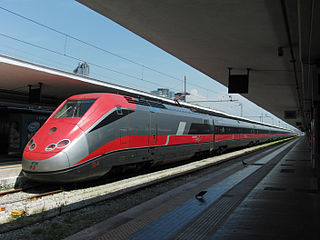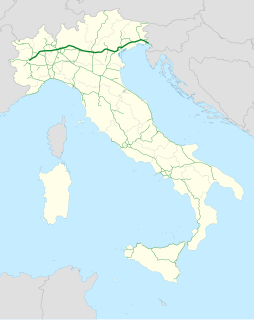
Transport in Spain is characterised by an extensive network of roads, railways, rapid transit, air routes, and ports. Its geographic location makes it an important link between Europe, Africa, and the Americas. Major forms of transit generally radiate from the capital, Madrid, located in the centre of the country, to link with the capitals of the autonomous communities.

Rail transport in Spain operates on four rail gauges and services are operated by a variety of private and public operators. The total route length in 2012 was 16,026 km.

Slovenian Railways is the state railway company of Slovenia, created in 1991.

Alta Velocidad Española (AVE) is a service of high-speed rail in Spain operated by Renfe, the Spanish national railway company, at speeds of up to 310 km/h (193 mph). As of December 2021, the Spanish AVE system is the longest HSR network in Europe with 3,622 km (2,251 mi) and the second longest in the world, after China's.

The Trans-European Transport Network (TEN-T) is a planned network of roads, railways, airports and water infrastructure in the European Union. The TEN-T network is part of a wider system of Trans-European Networks (TENs), including a telecommunications network (eTEN) and a proposed energy network. The European Commission adopted the first action plans on trans-European networks in 1990.

Bologna Centrale is a railway station in Bologna, Italy. The station is situated at the northern edge of the city centre. It is located at the southern end of the Milan-Bologna high-speed line, which opened on 13 December 2008, and the northern end of three lines between Bologna and Florence: the original Bologna-Florence line through Porretta Terme and Pistoia; the Bologna–Florence Direttissima via Prato, which opened on 22 April 1934 and the Bologna-Florence high-speed line, which opened to traffic on 13 December 2009.

High-speed rail in Italy consists of two lines connecting most of the country's major cities. The first line connects Turin to Salerno via Milan, Bologna, Florence, Rome and Naples, the second runs from Turin to Venice via Milan, and is under construction in parts. Trains are operated with a top speed of 300 km/h (190 mph).

The Autostrada A4, or Serenissima, is a motorway which connects Turin and Trieste via Milan and Venice. The city of Venice originally formed a bottleneck on the A4, but is now bypassed by the Passante di Mestre. The A4 passes just north of the city of Milan, where it is toll-free.
Railway companies in Europe assign their trains to different categories or train types depending on their role. Passenger trains may be broadly split into long-distance and local trains; the latter having average journey times of under an hour and a range of less than 50 kilometres. Goods trains have their own train types. The names of these train types have changed continually over the course of time.
The Trans-European conventional rail network, together with the Trans-European high-speed rail network, make up the Trans-European Rail network, which in turn is one of a number of the European Union's Trans-European transport networks (TEN-T). It was defined by the Council Directive 2001/16/EC of 19 March 2001.

Frecciarossa is a high-speed train of the Italian national train operator, Trenitalia, and a member of the train category Le Frecce. The name, which, if spelled "Freccia rossa" means "Red arrow" in English, was introduced in 2009 after it had previously been known as Eurostar Italia. Frecciarossa trains operate at speeds of up to 300 km/h (190 mph). Frecciarossa is the premier service of Trenitalia and competes with italo, operated by Nuovo Trasporto Viaggiatori.

Venezia Mestre railway station is a junction station in the comune of Venice, Italy. It is located within the mainland frazione of Mestre, and is classified by its owner, Rete Ferroviaria Italiana, as a gold category station.

Padova railway station, or Padua railway station, sometimes referred to as Padova Centrale, is the main station serving the city and comune of Padua, in the Veneto region, northeastern Italy.
The 2015–16 Copa del Rey was the 114th staging of the Copa del Rey. Going into the tournament, the winners were assured a place for the 2016–17 UEFA Europa League Group stage. However, since the two finalists, Barcelona and Sevilla, both qualified for the 2016–17 UEFA Champions League, respectively by winning the 2015–16 La Liga title and the 2015–16 Europa League, the cup winner's place in the 2016–17 Europa League group stage instead passed to the fifth-place team in La Liga, Athletic Bilbao.











